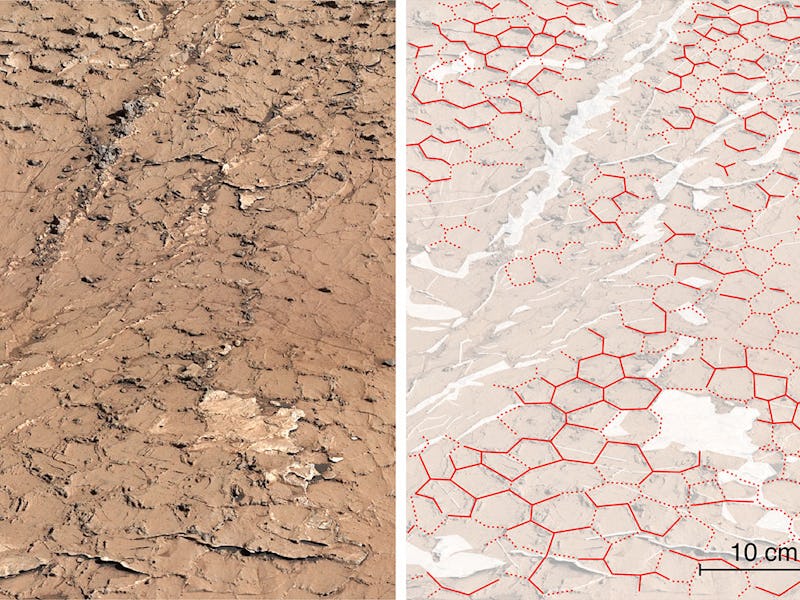NASA Rover Discovers Strange Hexagonal Patterns on Mars That Could Suggest Past Life
Mars once again delivers an enchanting science trove.

Hexagonal formations on Mars are record-keepers of its ancient wet environment — and may reveal if Earth’s neighbor could have ever supported microbial life.
On August 9, the journal Nature published a paper based on observations made by NASA’s Curiosity rover, a mission that, earlier this month, celebrated its eleventh year of exploring Gale Crater. There are cracks within the hexagonal formations the six-wheeled rover encountered in 2021 that formed “in fresh mud,” caused by ongoing and intense wet-dry cycles on the surface of ancient Mars.
These polygons hint at a critical transition in Mars’ global mineral composition, with important implications for life on Mars. “This indicates that the Noachian–Hesperian transition (3.8–3.6 billion years ago) may have sustained an Earth-like climate regime, and surface environments favourable to prebiotic evolution,” the paper authors write.
A portion of the Curiosity rover’s Mastcam panorama, where hexagons appear on the ground near a section of the rover.
What do these hexagons matter?
Climate models require a lot of data. Thankfully, these hexagons help fill in a gap.
Mars looks relatively barren today when compared to what it probably was like billions of years ago. Scientists know that Mars had persistent wet surface environments in its ancient history, but they have fewer clues about when that climate would move between wet and dry like Earth does. These are important to understand because, without them, models of ancient Mars’ hydroclimate are incomplete, and scientists are prone to drawing “diverging” results from one another.
That’s why the hexagons are a useful tool for Mars climatologists. The hexagons reveal these episodic changes, as their initial T-shaped junctions likely formed when the wet surface dried up. When water returned and softened up these cracks, they turned into Y-shaped junctions that make the hexagonal patterns.
According to a NASA statement that describes the findings, water does not always equate life-friendly conditions. There must be a finesse.
“Although water is essential to life, a careful balance is needed — not too much water, not too little. The kinds of conditions that sustain microbial life — those that allow a long-lasting lake, for example — aren’t the same as the conditions scientists think are required to promote chemical reactions that might lead to life,” write agency officials.
Life requires a balance to emerge
The hexagons on Mars’ surface are a sign that the right conditions may have existed to make polymers, the long chains of carbon-based molecules that act like the building blocks of life as we know it.
Polymers are forged through special chemical reactions. It turns out that polymers can form from short-term episodes of wet and dry conditions, like those behind the hexagonal shapes.
According to NASA, these cycles control the concentration of chemicals that feed the reactions required to form these building blocks of life.
Curiosity scientists are thrilled about the new findings. “Over 11 years, we’ve found ample evidence that ancient Mars could have supported microbial life,” Curiosity project scientist Ashwin Vasavada shares in the NASA statement. “Now, the mission has found evidence of conditions that may have promoted the origin of life, too.”
This article was originally published on